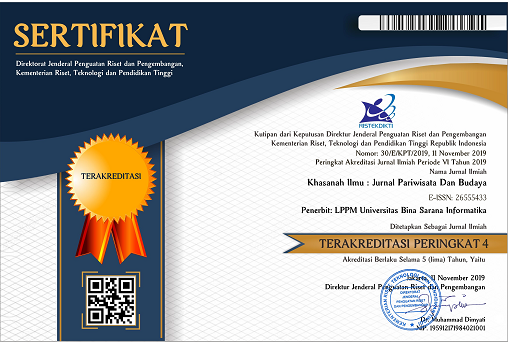Konsekuensi Consumer Engagement: Iklan dan Konten Media Sosial Berfokus pada Konsumen Restoran Indonesia: Perspektif Uses and Gratification Theory
Sari
Abstrak
Pada masa pandemi covid 19 ini kehadiran social media juga membangun pengaruh iklan dan konten di dalamnya untuk mempengaruhi konsumen restoran favorit di negara Indonesia dalam melakukan pembelian produk maupun jasa dan akan membangun consumer engagement. Sehingga, dalam pemasaran yang dilakukan oleh restoran tersebut pada saat ini juga memiliki dampak yang besar bagi keberlangsungan restoran untuk menarik konsumen yang ada demi menciptakan kestabilan pada restoran serta adanya waktu jangka panjang bagi restoran dalam melakukan ekspansi atau promosi terhadap perkembangannya tersebut. Kehadiran konsumen, merek, produk, serta layanan yang diberikan juga sangat penting bagi perkembangan restoran saat ini terutama yang mempengaruhi konsumen adalah dengan adanya informasi yang disebarkan di dalam content social media ataupun pengunaan iklan yang terdapat dalam restoran tersebut. Tujuan penelitian untuk mengembangkan model konseptual consumer engagement melalui konten media sosial dan iklan. Teknik pengambilan sampel menggunakan kuesioner secara daring dengan teknik non probability sampling. Sampel dalam penelitian yang valid sebanyak 120 responden. Metode analisis data menggunakan PLS-SEM. Hasil penelitian membuktikan bahwa semakin tinggi penggunaan iklan dalam promosi maka semakin tinggi tingkat consumer engagement, begitu juga semakin tinggi penggunaan konten media sosial maka semakin tinggi tingkat consumer engagement yang dapat disimpulkan seluruh hipotesis didukung. Penelitian ini memberikan wawasan kepada manajer pemasar restoran mengenai cara memanfaatkan konten media sosial dan iklan media sosial dalam meningkatkan consumer engagement.
Keyword : Content Social Media, Iklan, Consumer Engagement
Consequences Consumer Engagement : Advertisement and Content Social Media Focusing on Restaurant Indonesia Consumers A Perspective Uses and Gratification Theory
Abstract
During the COVID-19 pandemic, social media also builds the influence of advertisements and content to influence consumers of favourite restaurants in Indonesia in purchasing products and services and will build consumer engagement. Thus, the marketing carried out by the restaurant at this time also has a major impact on the sustainability of the restaurant to attract existing consumers to create stability in the restaurant, and there is a long-term period for the restaurant to expand or promote its development. The presence of consumers, brands, products, and services provided is also significant for the development of restaurants today, especially those that affect consumers are the information disseminated in social media content or the use of advertisements contained in the restaurant. The research objective is to develop a conceptual model of consumer engagement through social media content and publicity—the sampling technique used online questionnaires with non-probability sampling techniques. The sample in the valid study was 120 respondents—data analysis method using PLS-SEM. The study results prove that the higher the use of advertising in promotions, the higher the level of consumer engagement, as well as the higher the use of social media content, the higher the level of consumer engagement, which can be concluded that all hypotheses are supported. This research provides insight to restaurant marketers on utilizing social media content and social media advertising to increase consumer engagement.
Keywords: Social Media Content, Advertising, Consumer Engagement
Teks Lengkap:
PDFReferensi
Bijmolt, T.H., Leeflang, P.S., Block, F., Eisenbeiss, M., Hardie, B.G., Lemmens, A. and Saffert, P. (2010). Analytics for customer engagement”, Journal of Service Research, Vol. 13 No. 3, pp. 341-356.
Brodie, R. J., Hollebeek, L. D., Jurić, B., & Ilić, A. (2011). Customer engagement: Conceptual domain, fundamental propositions, and implications for research. Journal of Service Research. https://doi.org/10.1177/1094670511411703
Brodie, R. J., Ilic, A., Juric, B., & Hollebeek, L. (2013). Consumer engagement in a virtual brand community: An exploratory analysis. Journal of Business Research, 66(1), 105–114. https://doi.org/10.1016/j.jbusres.2011.07.029
Chen, S. and Lin, C. (2019). Understanding the effect of social media marketing activities: the mediation of social identification, perceived value, and satisfaction", Technological Forecasting and Social Change, Vol. 140, pp. 22-32.
Chen, G. M. (2011). Tweet this: a uses and gratifications perspective on how active Twitter use gratifies a need to connect with others", Computers in Human Behavior, Vol. 27 No. 2, pp. 755-762.
Cheung, C.M.K., Chiu, P.-Y. and Lee, M. K. O. (2011). Online social networks: why do students use Facebook?", Computers in Human Behavior, Vol. 27 No. 4, pp. 1337-1343.
Doorn, J.V., Lemon, K.N., Mittal, V., Nass, S., Pick, D., Pirner, P. and Verhoef, P. C. (2010). Customer engagement behavior: theoretical foundations and research directions", Journal of Service Research, Vol. 13 No. 3, pp. 253-266.
Gomez, J.B., Amado, J.B. and Montes, F. L. (2015). Impact of IT infrastructure on customer service performance: the role of micro-IT capabilities and online customer engagement", Proceedings of the 19th Pacific Asia Conference on Information Systems, Singapore, pp. 1-16.
Gummerus, J., Liljander, V., Weman, E. and Pihlström, M. (2012). Customer engagement in a Facebook brand community”, Management Research Review, Vol. 35 No. 9, pp. 857-877.
Harwood, J. (1999). Age identification, social identity gratifications, and television viewing", Journal of Broadcasting and Electronic Media, Vol. 43 No. 1, pp. 123-136.
Heinonen, K. (2011). Consumer activity in social media: managerial approaches to consumers' social media behavior", Journal of Consumer Behavior, Vol. 10 No. 6, pp. 356-364.
Hollebeek, L. D., Glynn, M. S., dan Brodie, R. J. (2014). Consumer Brand Engagement in Social Media: Conceptualization, Scale Development and Validation. Journal of Interactive Marketing, 28(2), 149-165.
Kahneman, D. (2011). Thinking, Fast and Slow, Macmillan, New York, NY.
Kaplan, A. (2012). If you love something, let it go mobile: mobile marketing and mobile social media 434", Business Horizons, Vol. 55 No. 2, pp. 129-139.
Katz, E. and Foulkes, D. (1962). On the use of the mass media as 'escape': clarification of a concept", The Public Opinion Quarterly, Vol. 26, pp. 277-388.
Kou, G., Chao, X., Peng, Y. and Alsaadi, F. E. (2019). Machine learning methods combined with financial systemic risk", Technological and Economic Development of Economy, Vol. 25 No. 5, pp. 716-742.
Kujur, F., & Singh, S. (2018). Emotions as predictor for consumer engagement in YouTube advertisement. Journal of Advances in Management Research, 15. https://doi.org/10.1108/JAMR-05-2017-0065
Lee, D., Hosanagar, K., & Nair, H. (2014). The Effect of Advertising Content on Consumer Engagement : Evidence from Facebook. The Wharton School, August, 1–42. http://www.researchgate.net/publication/257409065_The_Effect_of_Advertising_Content_on_Consumer_Engagement_Evidence_from_Facebook_*/file/72e7e52533d668b60b.pdf
Leiner, D.J., Kobilke, L., Rueß, C. and Brosius, H.-B. (2018). Functional domains of social media platforms: structuring the uses of Facebook to better understand its gratifications", Computers in Human Behavior, Vol. 83, pp. 194-203.
Malthouse, E.C., Haenlein, M., Skiera, B., Wege, E. and Zhang, M. (2013). Managing customer relationships in the social media era: introducing the social CRM house", Journal of Interactive Marketing, Vol. 27 No. 4, pp. 270-280.
Muntinga, D. G., Moorman, M., & Smit, E. G. (2011). Introducing COBRAs: Exploring motivations for Brand-Related social media use. International Journal of Advertising. https://doi.org/10.2501/IJA-30-1-013-046
Oh, O., Eom, C.Y. and Rao, H. R. (2015). Role of social media in social change: an analysis of collective sense-making during the 2011 Egypt revolution", Information Systems Research, Vol. 26 No. 1, pp. 210-223.
Oliver R.L. (1999). Whence customer loyalty. Journal of Marketing.
Palazon, M., Sicilia, M., dan Lopez, M. (2015). The Influence of 'Facebook Friends' on The Intention to Join Brand Pages. Journal of Product and Brand Management, 24(6), 580-595.
Peacock, J., Purvis, S. dan Hazlett, R. L. (2011). Which broadcast medium better drives engagement?: measuring the powers of radio and television with electromyography and skin-conductance measurements. Journal of Advertising Research 51(4): 578–585.
Prayitno, A., Putriani, A., Wibowo, A., & ... (2020). PENGARUH SOSIAL MEDIA MARKETING. CUSTOMER ENGAGEMENT DAN DIGITAL ADVERTISING TERHADAP KEPERCAYAAN MERK (Pengguna GO-JEK …. Jurnal Manajemen …, 33(2), 123–130. https://ejournal.stieibbi.ac.id/index.php/jmb/article/view/161
Rahmawati, E., & Aji, S. (2015). PENGARUH CUSTOMER ENGAGEMENT TERHADAP KEPUASAN PELANGGAN DAN KEPERCAYAAN MEREK SERTA DAMPAKNYA PADA LOYALITAS MEREK. Jurnal Riset Ekonomi Dan Manajemen. https://doi.org/10.17970/jrem.15.150204.id
Roscoe, J. T. (1975). Fundamental Research Statistics for the behavioral Sciences, 2nd edition, New York: Holt, Rinehart and Winston.
Sashi, C. M. (2012). Customer engagement, buyer-seller relationships, and social media. Management Decision. https://doi.org/10.1108/00251741211203551
Schindler, R.M. and Bickart, B. (2012). Perceived helpfulness of online consumer reviews: the role of message content and style", Journal of Consumer Behavior, Vol. 11 No. 3, pp. 234-243.
Sekaran, U., & Bougie, R. (2016). Research Methods For Business: A Skill-Building Approach. Wiley.
Verhoef, P. C., Reinartz, W. J., & Krafft, M. (2010). Customer engagement as a new perspective in customer management. Journal of Service Research. https://doi.org/10.1177/1094670510375461
Wang, W., Chen, R., Ou, C. and Ren, S. (2019). Media or message, which is the king in social commerce? An empirical study of participants' intention to repost marketing messages on social media", Computers in Human Behavior, Vol. 93, pp. 176-191.
Whiting, A. and Williams, D. (2013). Why people use social media: a uses and gratifications approach", Qualitative Market Research: An International Journal, Vol. 16 No. 4, pp. 362-369.
Yadav, M.S. and Pavlou, P. A. (2014). Marketing in computer-mediated environments: research synthesis and new directions", Journal of Marketing, Vol. 78, pp. 20-40.
DOI: https://doi.org/10.31294/khi.v12i2.10489










